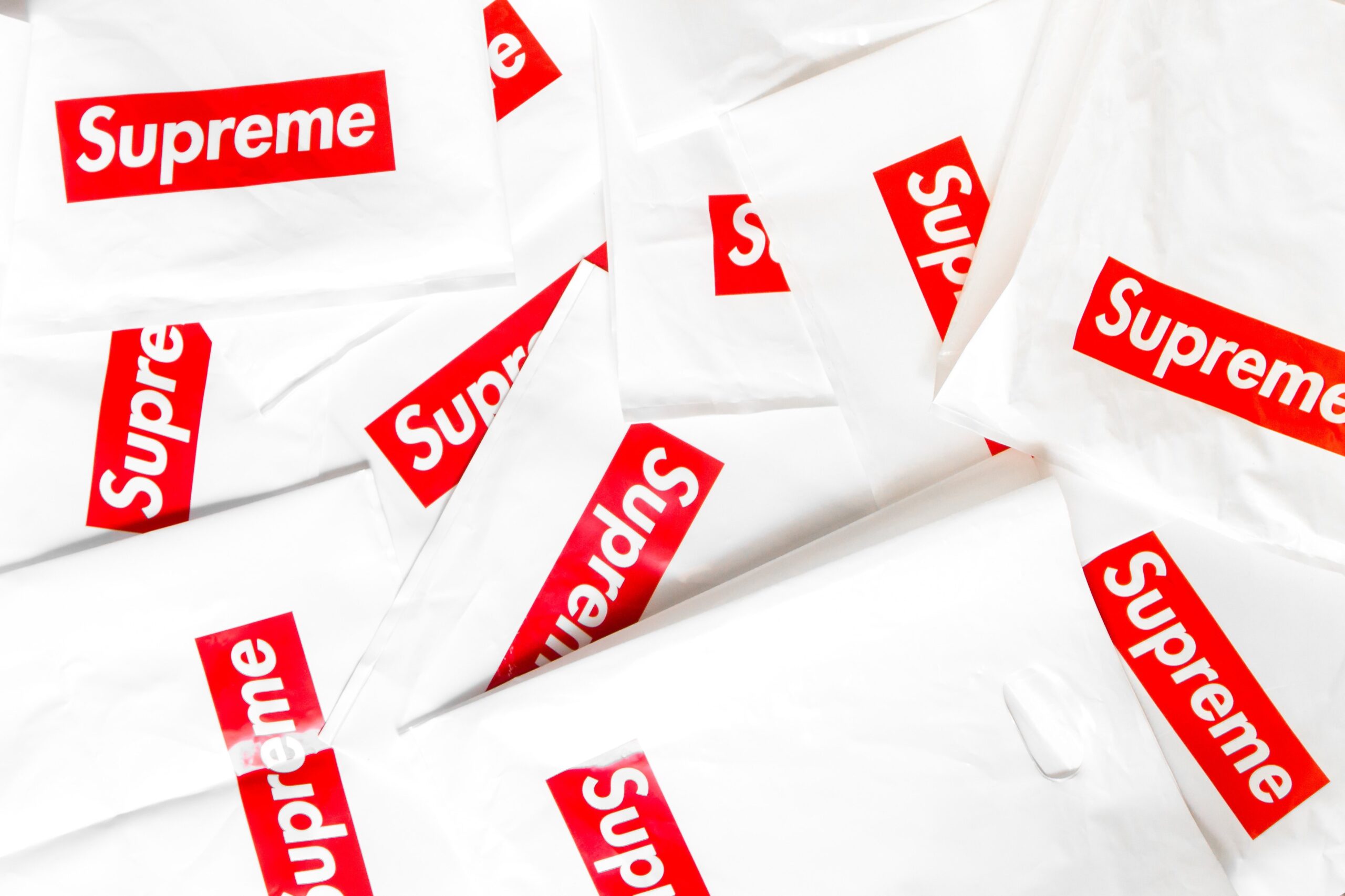CULTURE
Supreme’s Sale Makes One Thing Clear: Streetwear Has Left Behind the People Who Built It
10 Nov, 20

Original Supreme 274 Lafayette Store, NYC
Photo by David Lezcano on Unsplash
Streetwear as we know it now was built in SoHo.
When I moved to New York City in middle school, I was immediately infatuated with SoHo. What was hiding in these unnumbered streets? Who were these endlessly cool people in sneaker heels and hi-low dresses (it was 2012)? But mostly, who were the kids lining up all the way down Lafayette? I wanted to be them, their skateboards, their sneakers, their Supreme.
I dove into streetwear culture from a distance. I followed skate blogs on Tumblr, I bid on Vans x Supreme sneakers on eBay during high school study hall, and, on my trips to SoHo, I watched for any sign that someone else was like me, obsessed with this underground community. Seeing a logo flash on a T-shirt or a sticker on the backside of a skateboard made me feel like I was in on something that no one else knew. A kinship with the boy across from me at the crosswalk. A blood bond with the girl at the restaurant.
But then the game changed.
Yes, all the same kids were still camping for hours outside in wait for the latest drop, the newest shoe, but suddenly those weren’t the kids I saw flashing collaboration logos through SoHo. Suddenly it was rich kids on instagram, rich kids on the Upper East Side, rich kids who didn’t even know about the line that curves around Lafayette on Thursdays, who could afford the skyrocketing resale prices on emerging sites like StockX and Grailed.
It’s almost cliche now, the idea of pretentious kids lamenting how they miss the earlier days, the old streetwear and the old Supreme…but damn I miss it. But for me, it’s not about the exclusivity or my decreased chances at scoring grails—I never had much luck anyway. But there is no longer that nod, that acknowledgement, that kinship.
Streetwear is no longer a community. And Supreme’s $2.1 billion sale to VF Corporation has proven it.
Admittedly, this has been a long time coming. Though the internet is in flames about Supreme “selling out,” this has been the direction they’ve been headed for years. And amidst a global pandemic, where lining up in clusters to get into a crowded storefront is impossible (nobody’s trying to cop COVID), this sale feels inevitable.
When Supreme was founded in 1994, James Jebbia, founder and ex-manager of Stussy, wanted to create a safe haven for skaters. Blending skateboard and hip-hop culture, the brand’s focus was on being “cool.” A brand which initially catered to artists and skaters and Hip-Hop fiends—who were often Black kids in New York City—it ushered in a new era of streetwear and a new approach to retail: a “coolness” first business model.
The scarcity of its releases was initially an attempt to limit product waste and cater to the fickle mindedness of the “cool”— after all, what’s in one week won’t be next week.
After proving they had staying power, Supreme’s scarcity became a key aspect of its brand value. It wasn’t just a community built on being in the know; it was about being passionate enough to get what you wanted while you could still get it. But this founding ethos has been shifting for years.
Inarguably, the rise of resale and social media changed streetwear forever. Alongside the ever-growing landscape of Instagram Influencers and Internet hypebeasts, the supply remained limited, but the demand increased exponentially. Seemingly overnight, the newest streetwear was no longer reserved for those with the stamina to wait outside in the early hours of the morning. Now, anyone can have anything if they can pay for it.
When major resale platforms emerged around 2014-2015, some tried to retain the community-focused aspects of the culture, while others just facilitated the rising prices. This coincided with Supreme’s 50% partnership with The Carlyle Group in 2014. Now, it’s common to see high value streetwear items selling for two to four times their retail value, while the most anticipated releases — which are often limited issue collaborations — routinely go for over a thousand dollars.
Supreme’s collaborations are usually their most coveted collections. Frequent collaborators include Vans, The North Face, and Timberland — all brands under parent company VF Corp’s umbrella. To this end, the Supreme sale might seem like a good fit. One might even maintain a shred of hope that, with James Jebbia still at the helm and VF Corp’s promises to leave the brand alone, not much will change.
But the fundamental shift is this: Supreme’s sale signifies the end of the original era of streetwear. It’s the nail in the coffin of what has been a long time coming: the assimilation of streetwear into the mainstream. Some have lauded this sale as the official entry of streetwear into the adult market, but the transformation was already underway.
With mass distribution in the works, how can the Supreme brand retain its appeal in the long term? So far, it has. Though most of its profit comes from online sales, Supreme has expanded from its original New York store to 12 stores worldwide — four in the United States (New York, LA, and San Francisco), one in Paris, one in London, and six in Japan.
The streetwear renaissance in the mid 2010s changed the landscape for popular streetwear brands, but more notably ushered in the acceptance of streetwear aesthetics. Sweatpants are no longer reserved for the depths of your closet, they’re worn in clubs and styled for going out. During the pandemic, the legitimacy of loungewear and athleisure has been cemented.
As these aesthetics grew, high fashion followed suit. Virgil Abloh, now the menswear designer for Louis Vuitton, started with a niche streetwear label called Pyrex Visions and is most known for the streetwear giant, Off-White. Other major labels have taken on the signature oversized styles of streetwear aesthetics, and Nike’s SNKRS App, which launched in 2014, imitates the experience of waiting in those lines of yore, but on your phone.
But with so many of the original streetwear designers having moved onto high fashion and streetwear having entered the widespread retail market, the aesthetics remain but the community which inspired and fueled it has been left behind. It’s no surprise that these are Black kids. It’s no surprise that the “new,” “grown up,” version of streetwear is one that doesn’t include us.
The gentrification of streetwear is not just happening on a corporate level. The new age of small, niche streetwear brands is emerging in SoHo, but it doesn’t look like it used to. Neither do its loyal devotees. The new crowd wears polos and rugbys and loafers and class rings. The new crowd is white and middle to upper class, having their cake and eating it too — reveling in status symbols of wealth while benefiting from streetwear’s stamp of “coolness.”
New in SoHo are brands like Rowing Blazers and Aime Leon Dore, who balance streetwear, New York aesthetics with something new: prepwear. They follow the lead of Nolita mainstay, Noah, who famously combines skate culture with sailing culture. However, these new brands are focused on imitating luxury, grasping for upper class aesthetics while watering down their streetwear influences.
Even established brands like Kith, who’s following has remained strong and semi-esoteric over the years, is moving onto luxury partnerships, going from selling shoes and hoodies to stocking more lifestyle brands like Malin + Goetz and collaborating with New York luxury mainstays like Versace, Carbone, and Nobu. Most recently, Kith collaborated with BMW on a car, alongside car accessories and apparel.
Aime Leon Dore recently collaborated with Porsche in a series that included leather driving gloves. This is a long way from Supreme’s opening days, when its innovative store layout was built to allow skaters to skate right in from outside.
Now, the target audience is ambiguous. Now, scarcity isn’t an effect of limited supply; it’s a purposeful attempt at the appearance of luxury. After all, the most exclusive group is that of the wealthy. And don’t we all want to be them?
But I don’t. I always wanted to be one of the dirtrat kids with their skateboards and backpacks and T-shirts, waiting outside Supreme for the love of the culture alone. But that culture has abandoned us, so it’s time to stop clinging to Supreme as the hallmark of streetwear. The aesthetics Supreme drew from existed long before that store on Lafayette, and will continue to despite whatever this new partnership brings.
So, yes. Supreme sold out. But streetwear doesn’t depend on Supreme.














